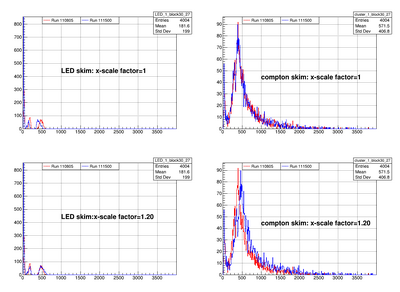AIEC Weekly Meeting June 1, 2023
Agenda:
- Previous Meeting
- Announcements:
- Activities:
- roboCDC:
- Hall-D is down for ~1yr.
- Model training script runs :)
- Test procedure for Hot Checkout just before next run?
- FCAL:
- FCAL correlation work: Torri's notebook
- roboCDC:
- Talks/Presentations
- CHEP talk Thomas
This plot shows one block (row=30, column=27) for two runs (110805 and 111500). All plots show the pedestal subtracted FADC pulse_peak values with no calibration constants applied.
- The two plots on the left are from the ``FCAL-LED`` skim
- The two plots on the right are from the ``compton-neutral`` skim (see description below)
- The two plots on the top are the original, raw data with no scaling factor applied
- The two plots on the bottom have a relative scaling factor of 1.2 applied to the run 111500 values
The scaling factor of 1.2 is done by eye to make the LED plots in the lower left roughly lined up. The plots on the right use light generated in the FCAL block. The fact that the spectra in the top right look well aligned by eye, but are not well-aligned in the lower right plot suggest that the scaling factor of 1.2 is due to the LED light source rather than the PMT response.
The two plots on the right were made by looking at reconstructed FCAL clusters where bock 30,27 was the center. The goal here was to have a distribution with some structure that allowed one to test if there was any relative scaling of the x-axis.
Minutes
- We shared with Igal what we have learned regarding the lack of correlation between LED peak position and existing calibration constants (gains) from the CCDB.
- David's anecdotal plot (see above) was discussed.
- We discussed what previous evidence Igal had seen for a correlation. He noted that the results were inconsistent across blocks.
- We reviewed some of Igal's plots from the Feb. 22, 2023 AIEC meeting.
- We noted that the strongest evidence appeared to be from the block 1344 in ring 1 plot. However, we concluded that this was most likely due to radiation damage.
- We looked for evidence in the block 707 in ring 9 plot, but were not convinced that a correlation was clearly evident.
- We reviewed some of Igal's plots from the Feb. 22, 2023 AIEC meeting.
- We reviewed some of Torri's plots where the ratio of individual blocks to the sum of all blocks was plotted against the pi0 derived calibration constants.
- Igal noted that the quadrants have different pulsers so we should use the overlap of a ring with the quadrant for the average rather than the whole FCAL.
- We may also want to plot individual colors so the x-axis stretches out more to show potential correlations.
- Igal suggested one cause of the LED amplitude shifts could be due to temperature changes related to frequent accesses to the FCAL dark box during the first PrimEx run (run numbers 60XXX). He said they did not observe so many fluctuations in the section PrimEx run which had fewer dark box accesses.
- Igal suggested looking at the CompCal might be easier since it had a more carefully designed LED system that was much more stable.
- n.b. the CompCal has since been disassembled and will never be in use again.
- David suggested spending 1 more week to seek out a LED-gain correlation in the FCAL and then pivoting to the CompCal.
Action Items
- Investigate temperature for a possible correlation with the LED peak position drifts
- Reproduce ratio plots vs. CCDB values:
- use only reliable blocks from same quadrant for sum
- Plot only small and large blue so x-axis covers smaller range
- Decide how to proceed for remainder of project (FCAL, CompCal, other?)
